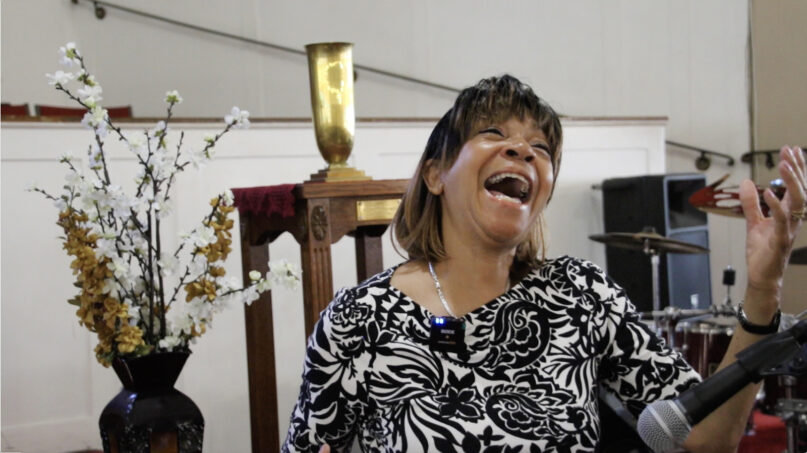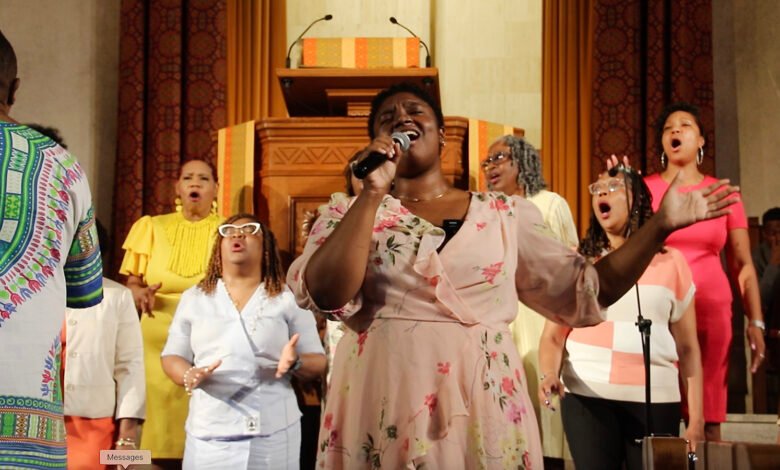NEW YORK (RNS) — On Sunday mornings in Brooklyn, nicknamed the borough of churches, the muffled sounds of choir singers, hand‑claps and Hammond organs can be heard from the sidewalks. The borough still has a church on nearly every block, but over the years, the number of people in the pews has thinned.
Many church choirs in the heart of Brooklyn, however, have kept singing — despite boasting fewer singers than in years past as neighborhoods face gentrification and organized religious affiliation decreases.
Standing in front of the gospel choir at Concord Baptist Church of Christ in the Bedford-Stuyvesant neighborhood, Jessica Howard, 25, led the gospel standard “God Is” on a Sunday in July. Dressed in a powder-pink floral dress, she called out lines naming God as “joy in sorrow” and “strength for tomorrow.” Some choir members wiped away tears as the song stoked emotions from around the room.
“As a Black Christian person, as a descendant of slaves, I think when I sing, I feel really connected to my ancestors,” said Howard, who grew up in Virginia and now sings as a soloist at Concord, where she’s been a congregant for six years. “I really feel sometimes like it’s not just me singing, it’s my lineage singing.”
Founded in 1847, Concord Baptist Church is Brooklyn’s oldest historically Black congregation. At the time, a nearby neighborhood known as Weeksville, now considered part of central Brooklyn, was the second-largest free Black community in the United States before the Civil War, said Amanda Henderson, collections historian at the Weeksville Heritage Center.
Louise Nelson, a Brooklyn native and church historian of the Berean Baptist Church in Crown Heights, said music was the foundation of the early church, and that remains true for churches in the borough today.
“The songs that uplifted us and kept us going through the midst of our misery — music is who we are,” Nelson said. “I don’t think you can have a church today without the music because it brings unity in that idea that we can all do it together.”
According to Pew Research Center data, between 2019 and 2023, Black Protestant monthly church attendance fell from 61% to 46% — the largest decline among major U.S. religious groups. The COVID-19 pandemic accelerated this trend, and its impact is visible in the thinning choir stands.
Glenn McMillan, Concord’s director of music ministry and a musicology teacher at the City University of New York, who has worked in New York City church choirs since 1994, recalls a time when historically Black churches in Brooklyn regularly had multiple choirs at each parish.
“In the last 20 years, the members of church choirs started getting older because this generation does not see church as important as it was back in the day,” McMillan said.
The choir at Concord has shrunk from about 50 voices before the pandemic to 30 today, McMillan said. Back in 2006, the choir featured 100 voices.
According to research published by covidreligionresearch.org in June, Black Protestants attended church on Zoom more than other denominations during the pandemic, and they have been the slowest to return to in‑person worship.
“The internet has taken over and streaming has taken over,” McMillan said. “People don’t go into the building as much as they are streaming it.”
McMillan said that when in-person services first resumed, it took a long time for the choir to rebuild because many members were still staying home for health reasons. Recently, though, he’s seen more people showing up.
“I’m begging people my age to come to Concord,” said Howard, the youngest member of the gospel choir, adding that only a handful of people around her age attend the church.
RELATED: In ‘Gospel’ docuseries, Henry Louis Gates Jr. explores Black church’s music, ministers
Gwen Davis, a senior member of Berean Baptist Church and a choir soloist for more than 40 years, recalled Easter services in the mid‑1960s, when over 400 people filled the pews and four separate choirs led the congregation in song.
“It was a lot of energy,” Davis said. “Your ear got trained really well.”

Gwen Davis sings at Berean Baptist Church on Bergen Street in the Crown Heights neighborhood of Brooklyn, July 31, 2025. (RNS photo/Fiona Murphy)
Today, Davis said, a typical service attracts approximately 150 people, and roughly 100 virtually. Over time, Berean’s choirs have consolidated into a single mass choir with approximately 20 singers.
A professional soloist who has been singing at different churches across Brooklyn throughout her adult life, Davis said she believes one reason for choirs thinning out is the decline of music education in New York City Public Schools.
“When I was in high school, I had music every day,” said Davis, who attended high school in the 1970s in central Brooklyn. “I don’t think the children are learning notes and sharps and clefs. I mean, that was like general knowledge for us at the time.”
During the 1970s fiscal crisis, the city of New York eliminated thousands of teaching positions, including art and music teachers, and converted music rooms into other classrooms, narrowing arts access in schools in low-income and majority-Black neighborhoods.
“For me, singing is not just singing, it’s ministry,” Davis said. “Some of these old hymns were composed years and years ago, and those old hymns have sustained a people — many people.”
Gentrification is another force reshaping Brooklyn. Between 2010 and 2020, Crown Heights lost nearly 19,000 Black residents while gaining about 15,000 whites, according to 2020 Census data. More than 75% of Bedford-Stuyvesant residents in 2000 were Black, while in 2020, around 41% were Black.
Those demographic shifts have hit historically Black Catholic parishes hard. St. Teresa of Avila in Crown Heights, which was the first church in the nation to hold Mass in Creole, will close by the end of the year. The anticipated closure demonstrates a wider pattern of Catholic churches that serve people of color closing, often attributed to declining attendance.

Cantor Mike Delouis sings during a service at the Co-Cathedral of St. Joseph in the Prospect Heights neighborhood, Sunday, July 6, 2025, in Brooklyn, N.Y. (RNS photo/Fiona Murphy)
For Mike Delouis, 38, St. Teresa’s longtime cantor and a son of Haitian immigrants who was baptized at the church, the loss is personal.
“Singing for me is not about performance but about participation,” said Delouis, who juggles three services most Sundays between St. Teresa and the Co-Cathedral of St. Joseph in Prospect Heights. “St. Augustine said singing is praying twice.”
Delouis is part of a group fighting to keep the parish open, hoping to preserve a piece of their history in a rapidly changing Brooklyn. “Even through the process of gentrification, there are people that hear the music and they come in,” he said.
RELATED: Parishioners battle diocese over closure of historic Brooklyn church
In June, from his place in the choir loft, Delouis heard the priest announce the church’s closure. The words hit hard. “It was actually kind of hard to finish,” he said. “We only had the closing hymn to do, and I thought, ‘Oh my gosh, no — we can’t let this happen.’”
Jesteena Walters, 55, has been part of Bedford Central Presbyterian Church in Crown Heights since she was an infant. She began singing at age 6 in the junior choir, and when she turned 18, she transitioned to its Gratitude choir, which her older siblings also joined. “It was the young hip gospel choir of the church,” Walters said.
Today, Gratitude no longer exists in the same way. Its members are older and often reunite only for special occasions, such as singing at funerals. Over the decades, Walters has also watched the congregation itself shift demographics.
“When I first went to Bedford Central, it was primarily a white church, and so we were in the minority at the time,” Walters said, referring to the early 1970s. “In the years that would come, it was primarily a Black church.” It later became home to a large West Indian population, and today includes many members of Guyanese heritage.
“To be honest, I couldn’t break down the history of Brooklyn in a way that says who came first,” Walters said. “At the end of the day, I believe in people coming together, if we can truly connect, feel each other’s pain and celebrate each other’s joys.”
McMillan emphasized that choirs continue to play a central role in Black church life, even as congregations decline in membership. “Choir singers are some of the most faithful churchgoers,” McMillan said. “A choir is a community within the church community, and whenever you have a really consistent and strong choir, they grow with one another.”
Howard said she hopes to become a choir director one day, and she credits McMillan and the gospel choir for encouraging her toward the role.
“I’d like to follow in that tradition,” she said.








